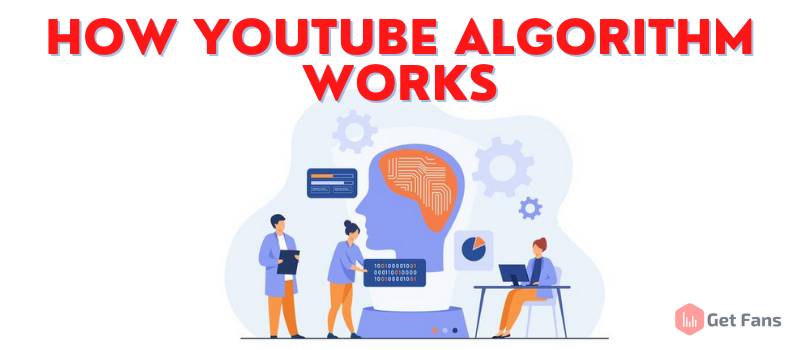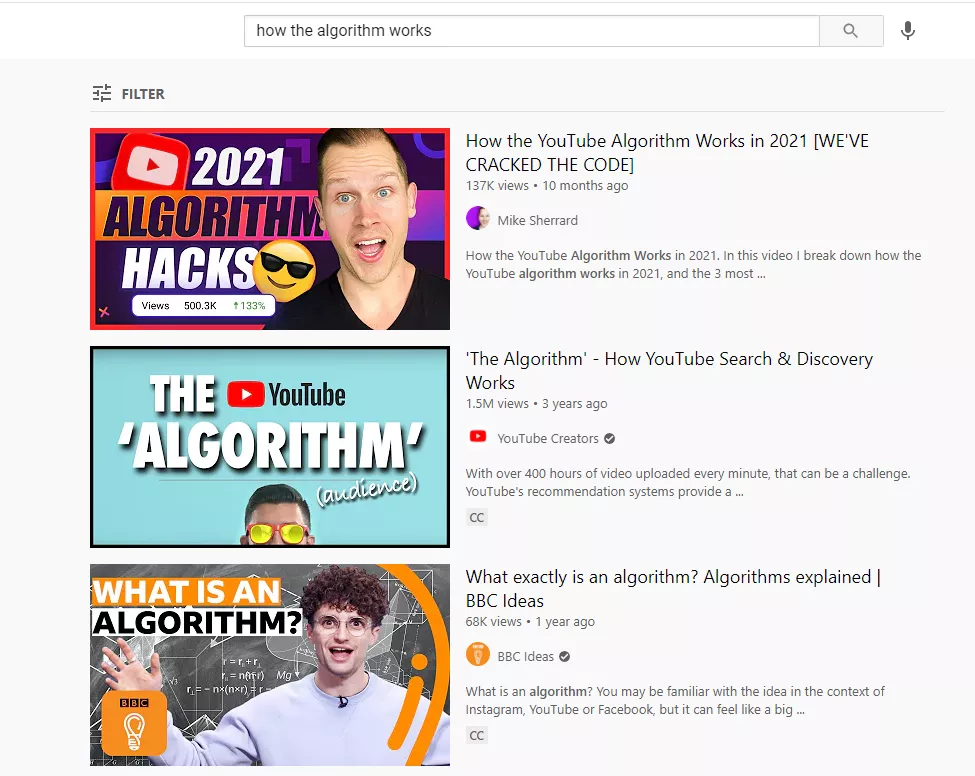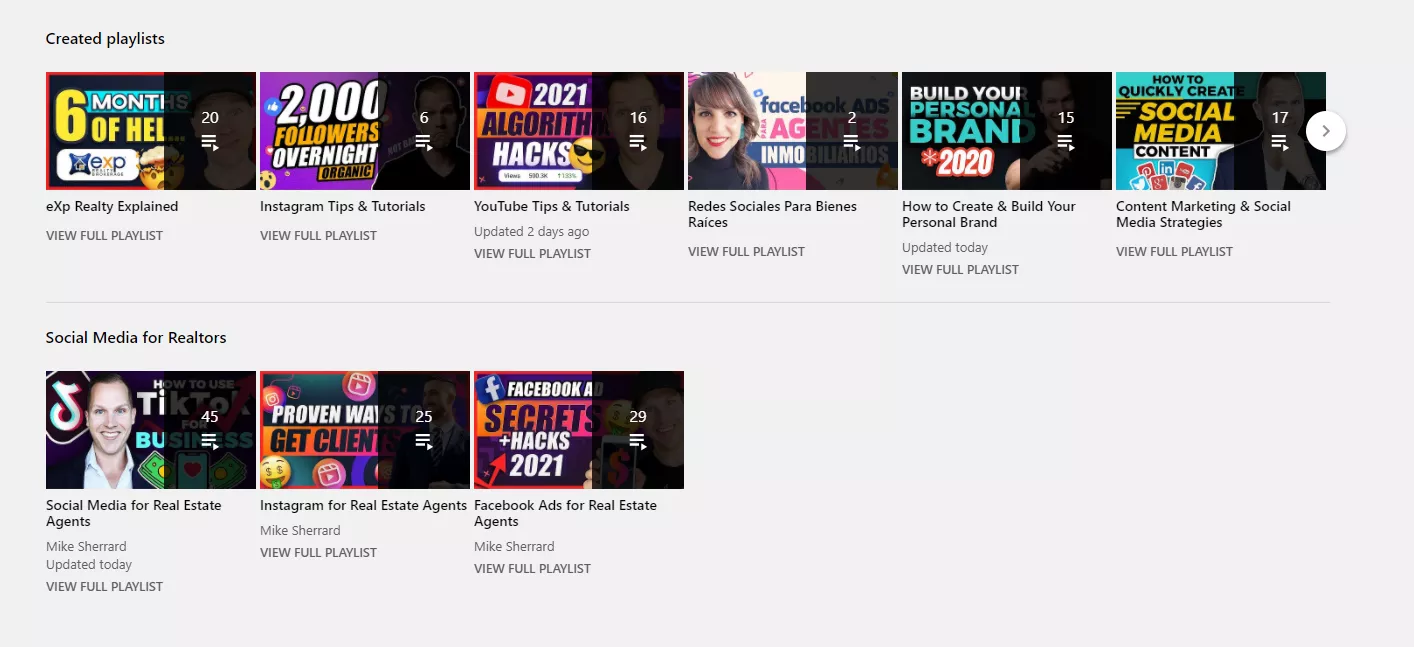



YouTube’s algorithms are as mysterious as they come. In the past, no one really knew what the algorithms did or how they worked because YouTube (and Google) kept fairly silent on the processes behind the scenes. However, since Google released an article called “Deep Neural Networks For YouTube Recommendations”, the mystery behind YouTube’s algorithms dissipated and as of 2021, YouTube’s algorithms are easier to maneuver and work with.
Also, have you ever noticed how YouTube shows you videos that match your interest and browsing history? For example, if you watch many cat videos, then YouTube automatically recommends more cat videos to you. YouTube algorithm is a feedback loop that YouTube creates by analyzing the browsing pattern of individual users.
In this article, we’re going to explain how YouTube’s algorithms work and how you, the creator, can work with them. We’re also going to give you some tips and tricks on working the algorithms in your favor so you could grow your channel on YouTube organically. So, without further ado, let’s dive right in.
The YouTube algorithm is essential because it lets you discover more content that's relevant to you. For YouTube and content creators, it helps them retain more viewers.
However, to understand how YouTube algorithms work, we need to get familiar with the history of YouTube algorithms and their relevance to watch time, comments, and view count.
It is also important to note that algorithms change over time, so YouTube algorithm 2020 will be pretty different from YouTube algorithm 2021.
When YouTube was launched, it rewarded videos that was getting more video views than those that managed to retain viewers.
While trying to figure out how the YouTube algorithm works, several YouTubers found a loophole around this click count and started uploading clickbait videos with misleading titles and thumbnails. This was when YouTube realized that this behavior was ruining the user experience. It decided to change its approach to recommend videos to people browsing the site.
Watch time, or view duration, came into effect in 2012 — this was when YouTube started recommending videos based on how long people watch them. This helped YouTube decide what sort of videos people were walking, against what they were clicking on.
YouTube keeps on encouraging people to make videos worth watching so that viewers had a more engaging experience. However, as creators, it always helps to know about the YouTube recommendation algorithm. And you can play around it to get better results. However, ensure that you have a healthy and organic watch time.
During this period, YouTube also implemented comments count as a factor in ranking videos on the platform. A video with enough interesting comments would mean that people are checking it out and enjoying it. However, the comment alone could not determine if a video is doing well. When balanced with likes, it would just offer the formula used to rank YouTube videos better.
The introduction of the commenting factor helped determine whether a video was also interesting enough for people to participate in discourse or have fun in the chat. One rule of thumb is that if you are getting enough comments organically and through a social share, you are halfway into figuring out how the YouTube algorithm works. The start is almost always around creating high-quality videos that deserve the attention and hype.
Between 2005-2021, one of the other ways to rank videos on YouTube came around the like count. The like count on a video would suggest how many people approved the video or saved it to watch later.
The entire point of YouTube trying new things and experimenting over the years was to develop a concrete formula that could help rank videos on YouTube. So far, it has been fairly successful, but not without establishing some boundaries.
So there are videos that do not directly violate YouTuber's user policies. However, indirectly, these videos can be pretty misinformative or might have a standard that is considered below par when sharing opinions and facts.
More recently, YouTube has tweaked its algorithms to avoid borderline content as much as possible, and this ensures that it does not aid in the spread of misinformation. In the larger picture, tweaks such as these in the YouTube algorithm help the platform remain informative, reliable, and hoax-free.
YouTube algorithm 2021 is proficient and learns on the go. It takes a note of user action and behavior, gets to know their area of interest, and suggests videos accordingly. The videos are selected and laid out in a way where it's targeted to drive engagement through an effective Click Through Rate (CTR).
The engagement style is also dependent on what the user prefers, and this also comes to the video length. If they are into watching short videos, then the most recommended video length will be short for videos. Similarly, if a user watches longer videos, YouTube will begin recommending videos that are longer. If you want to know what YouTube algorithms are, then it becomes essential to figure out its working principles, such as the ones below.
Machine Learning is an excellent way for YouTube to reduce time spent allocating human resources to critical data collection areas. With Machine Learning, YouTube ensures that it keeps learning with the user's behavior.
The YouTube algorithm is designed to drive maximum engagement out of a visitor while also satisfying their search query while leaving them wanting more.
YouTube has a search and discovery option where you can input a query to find videos around it. Your query could be the name of the video, artist, or channel name — YouTube would accept your query and serve you with the most relevant results.
YouTube also allows you to filter your search to give you more control over how exactly it scans its database.
YouTube also has a Discover section where you can come across new content based on your taste. These features are also updated with YouTube algorithm changes.
The YouTube algorithm follows the audience by noting their habits and their taste by taking into account the kind of videos they like and find themselves engaging most with. That way, YouTube can determine what works best for the user.
Please note that more information on the subject can be derived from search queries such as 'YouTube algorithm reddit.'
YouTube search works by running the user query through several filters, such as date, relevance, and popularity. That way, users can tweak the filters to come across the desired result. By default, YouTube tries to show the most relevant result from a trusted and popular source. Understanding of YouTube search is another step closer to knowing how the YouTube algorithm works.
YouTube search collects feedback from the users by letting them choose which result is relevant to them. If a user does not want to see a specific pattern being presented by the search result, they can choose to remove it and even let YouTube know the reason behind it.
That way, YouTube accesses direct input from its users, making it even more relevant and precise in the long run.
A lot of factors go into determining which video is trending. Trending videos mean that a video is doing well on the internet across or specific to geographies, languages, interests, and age groups.
However, most videos that come into trend are the ones that appeal to a lot of views without being sensational or misleading.
YouTube selects videos from different creators, and some of the factors that go behind it are view count, traffic, age of the video, and how the video performs compared to recent uploads on the same channel.
YouTube combines these signals to come up with a list of videos that are trending. YouTube notes that the trend feature is not biased. It puts great effort into determining which video can become a trend, including making sure that it is safe for the community and abides by all terms and conditions. Understanding the YouTube algorithm also helps in determining which videos work well for trends.
YouTube subscribers count and subscriptions can be vital in determining if a video deserves to become a trend or even serve as a recommendation on the platform.
If there are two videos on the same subject, the one from a channel with more subscribers might receive priority when it comes to displaying results. However, this might not always be true — YouTube algorithms keep changing and are highly anticipatory of the user's behavior.
Notifications on YouTube are a great way to stay updated on the latest content uploaded by your favorite channels. Depending on your notification preferences, YouTube will update you with the latest and make it more accessible for you to browse through your favorites. Depending on your taste, YouTube could learn what videos most interest you and send you notifications accordingly.
Click baits are annoying. You find a video you thought might be interesting, but then it turns out it is just fluff. These videos can also be a waste of advertising dollars as sometimes they never manage to generate much engagement beyond attracting visitors.
By ranking videos from trusted channels known for creating high-quality content, YouTube ensures that it keeps clickbait away from your feed. However, if a user has grown to like sensational and clickbaity videos, YouTube could further push them down the rabbit hole.
YouTube also looks at the watch time to determine if someone watched a video or not. Most clickbait will attract visitors, but many might eventually realize that there is no real value in these videos. This could result in a drop in watch time.
By taking a healthy watch time into account, YouTube also determines which videos are more reliable and come from trusted sources.
Now that we’ve gone over all the sections on YouTube and how the algorithms work in each section, it’s time to do more than just talking - it’s time for practicality. In this part of the article, we’ll present different ways that you can optimize your videos to cater to YouTube’s algorithms.
We’ve gone over the importance of keyword research in a lot of other articles here on GetFans, so we won’t dive too deep into this subject. But the gist of it is that you have to target relevant keywords in the video’s metatags (title, description and tags) to make sure your video appears to people who search for the same keywords. If your video is about knitting, your target keyword could be “how to knit for beginners” and your video will likely appear to people who searched for that keyword if you used it in the video’s title, description and tags.
In the example below, you can see that we searched for the keyword “how the algorithm works” and the very first video has those keywords in the video title and description (in bold letters). This is a fine example of how YouTube’s search algorithm works. Never underestimate the importance of keywords -

This is a fine example of how YouTube’s search algorithm works. Never underestimate the importance of keywords!
Using a good title and thumbnail combination will increase your video’s CTR, or Click-Through-Rate. The principle behind this is simple - people are visual creatures. They notice thumbnails first. Therefore, if your video has an engaging thumbnail, people will feel compelled to peek at your video’s title. Once they did that and confirmed that this video will fulfill some urge, need or answer a question they might be asking, they’re more likely to click on it and start watching it.
The more people click on your video, the higher your CTR is. Videos with high CTR are seen as highly compelling by the algorithms and are often pushed up the ranks because the algorithms see them as relevant - since so many people clicked on them. Here’s an example of a good thumbnail and title combination:
This thumbnail has a very clickable word in it - Hacks - and the title contains exactly what we were searching for in the first place.
The algorithms are looking for videos that will keep people on the platform for prolonged periods of time. This is an actual fact. Therefore, you should consider making your videos into a “series” format rather than “one-offs”. People love watching series (Netflix binges are proof of that), and they can watch series on YouTube as well. If your videos can’t be made into a series - put them in a playlist with other videos under the same topic.

In this example, you can see that the creator Mike Sherrard organized his videos into playlists that revolve around the same topic so people could find similar videos to watch more easily and their watch session will probably be much longer than if they had to manually search for videos one-by-one.
Engagement is one of the most important video performance metrics that the algorithms look at when determining whether to “push” a video or not. If you want more comments on your videos or more likes (or dislikes, since they are a form of engagement too!), you have to remind your audience to do those things by using CTAs in the middle of your videos and towards the end.
YouTube isn’t a huge fan of “dead” channels. If you’re uploading videos consistently, YouTube knows you’re still relevant and will be more likely to push your content forward. There’s another perk to posting consistently - your audience knows when to expect a new video from you and they’ll sit there, waiting patiently for the video to be released. Once you’ve released your video, you can be sure that they’ll watch it, thus increasing your watch times and audience retention rates. The higher these are, the more compelling your videos are to the algorithms. The more compelling your videos are, the more likely the algorithms are to promote your videos on the platform in the different sections. It’s that simple.
The best thing you can do on YouTube is to create content that people want to watch. You can’t just toss any video out into the void and expect it to be picked up by the algorithms - your videos need to have production values and they need to have an actual value for your viewers. So whether you’re doing How-Tos or Prank videos, it’s all the same - you have to make sure that people want to watch the video all the way through. We’ve mentioned how you can do that in another article about ranking on YouTube, so make sure to check it out later if you haven’t already.
Using YouTube Analytics is one of the most important things you can do. Your analytics will give you insight into everything you’re doing right and wrong on your channel. Do your videos have low CTR? Maybe you should change your thumbnails style. Are people dropping off at a specific point in every single one of your videos? Maybe you should skip that part altogether. There’s so much to learn from YouTube Analytics, we cannot stress their importance enough.
YouTube Shorts are gaining much popularity. Much like Instagram Reels, YouTube allows uploaders to share short videos. YouTube recommends its shorts based on your browsing history and the kind of content you are interested in. It also learns from your response and gets better with time.
So there you have it - we’ve now discovered how the YouTube algorithms work in 2021 and what you can do with them and not against them. The truth is, there is no surefire way to hack the algorithms - but there are ways that you can work with the algorithms, and that’s the greatest hack around.
